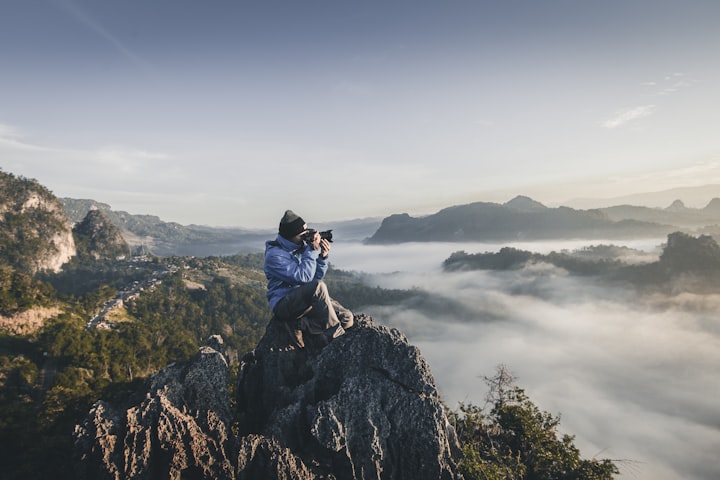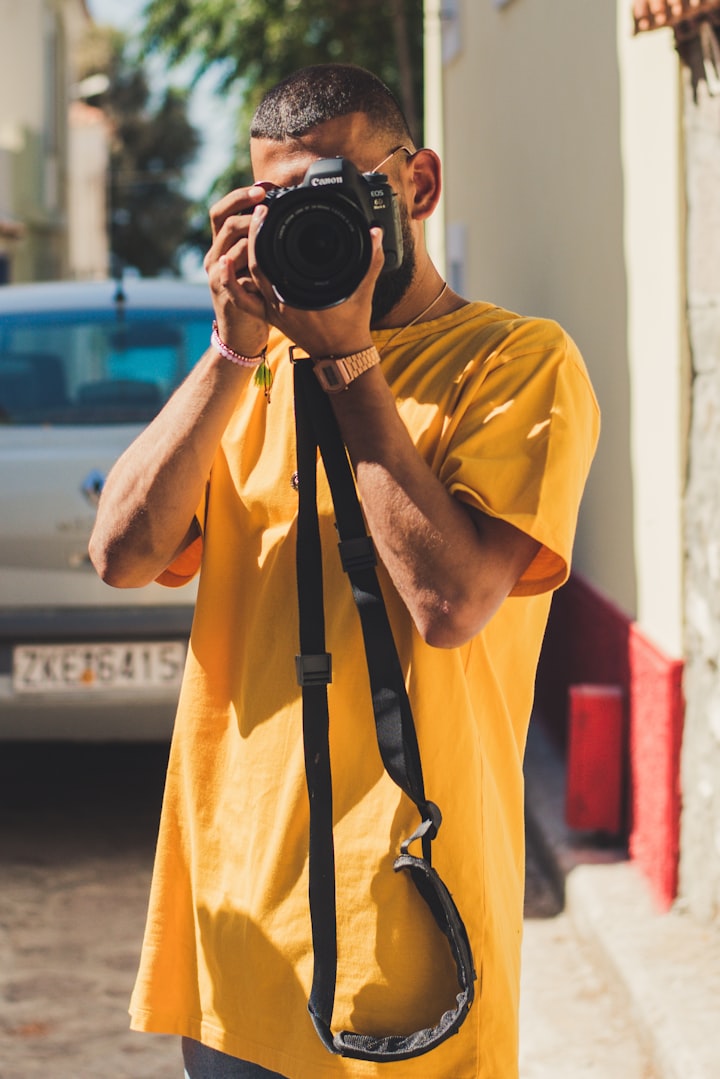Aperture (ƒ) - Filling Our Camera with Light
How is it that aperture affects our exposure? What does it do to certain elements of our image?

Hello all, and we're back with another blog! Last week we went over shutter speed and how it affects our images, and talked a little bit about how it is a conveyance of time in our images. If you missed it, you can read it via the link below
This week we'll be talking about aperture, describing how it works, what it does, and how it affects our final product. We'll also talk briefly about different types of lenses. Without wasting anymore time, let's jump in.
Aperture (ƒ) - What is it?
Aperture is a term that relates to our lens, and how “open” or "closed" it is. It is often represented by a curly (or italic latin) letter "f"—like so, ƒ (called a "florin," but simply described and pronounced as "f" for photography). The more open the lens, the more light will enter, and a more closed lens will let in less light. In theory it's a very simple concept, albeit slightly confusing to wrap your head around in the beginning due to how we describe apertures (which we'll cover in depth below).
So if aperture is directly related to our lens, and how open or closed it is, our lens is obviously an important element of this formula. We'll briefly discuss lenses for this article, because they are so intertwined, but we'll try to focus mainly on how using aperture affects our photos without getting too nitty gritty in this blog. We'll keep the intense science and physics for another blog in the future.
Time out: It's important to know that our ability to select an aperture is dependent on our lens, and different lenses will affect this. The type of lens will affect what aperture is available to us, and it is important to understand the differences between types of lenses. We'll talk about Prime and Zoom lenses

Prime Lenses: These lenses offer a fixed focal length, meaning if we want to get more or less into our photos we need to physically move the camera. Common focal lengths for these lenses are 35mm, 50mm, 85mm. Common maximum apertures for prime lenses are ƒ1.2, ƒ1.4, and ƒ1.8.
Zoom Lenses: These lenses offer a range of focal lengths, this means to an extent we can get more or less of a scene into our image by keeping our camera where it is. Common zoom lenses are 18-55mm, 24-70mm, 70-200mm. Aperture for zoom lenses work differently though, there are two types of lenses, variable, and constant aperture:
- Variable aperture lenses display two numbers as their ƒ-stop, for example, 18-55mm kit lenses have an aperture of ƒ3.5-5.6. This means at 18mm they can open to ƒ3.5 and at 55mm they can only open to ƒ5.6.

- Constant aperture lenses display a single ƒ-stop, for example the 24-70mm ƒ4, can open at ƒ4 at 24mm and stay open at ƒ4 all the way through the focal range all the way up to 70mm.

As we mentioned, aperture is represented by the curly "f" -ƒ-, but how do we as people read or interpret what that ƒ stands for? Aperture is displayed as ƒ followed by a number. This can be anywhere from ƒ0.95 (one of the widest openings available, incredibly expensive, and often unnecessary outside of astro photography) or ƒ22 (common for most lenses). The smaller the number, the wider the opening, and thus more light enters our image (example ƒ1.8 a common widest aperture for many prime lenses). The larger the number the smaller the opening, and thus less light that will be enter the image. As an example, these apertures listed in sequence will go from most open to least open—ƒ1.8, ƒ2.8, ƒ4, ƒ5.6, ƒ8, ƒ10, ƒ14, ƒ20—There are many other stops available, but just for this example, ƒ1.8 is the smallest number listed, but also opens the widest of those listed.
How does it work?
The lens, and how wide it can "open," or how narrow it can "close" is what we'll briefly discuss here. But what do these terms mean? Our lens is already a closed unit, it doesn't open or close. The lens itself is often a sealed unit, and you're pretty much ready to go when you buy it. But inside your lens, and if you have one near by, try this out, look through the front of the lens, there is a section that has what look like tiny fins overlapping on each other. This little section of fins is what we reference when we say "open" or "closed". (Or if you don't have your camera handy, scroll up and have a look at the banner image for this article, that's the fins described, they may look different on other lenses).
When we dial in an aperture on our camera, the camera will open or close the little fins the required amount to allow us to take a photo at our desired aperture. Most the time, the camera will do this for us, unless we have a manual aperture lens, then there's often a way to change the aperture via a little dial on the lens itself.
What does it do to our exposure?
Aperture affects our exposure in very consistent ways. More open, more light; less open, less light. The easiest way to think about this is to think of a wide open aperture like a fire hose, and a closed aperture like a garden hose. If we turn both hoses on for the same amount of time, which will give out more water? This is how aperture affects the amount of light we can receive, more open is equivalent to a larger hose shooting out more water (more light that we can receive). As it is incredibly consistent in it’s impact on our exposure and the image it will produce, I personally recommended for beginners that are trying to shoot on manual to set their aperture they require for the shot first, then adjust shutter speed, and ISO subsequently (this will be explained more in next fortnight's blog about combining our three elements of the exposure triangle).
But if we're getting more light by having a wider aperture, why don't we always shoot at the widest aperture we can? Outside of not always wanting as much light as possible in a photo, there are other things to consider. This leads us to our next topic.
What does it do to our final product?
Aside from just letting in more or less light, our aperture affects our images in other ways. A concept called depth of field, and also lens diffraction. Depth of field and lens diffraction are expansive topics that can be covered at a later time, but understanding the basics is necessary.
Depth of field—Think of depth of field as an invisible wall that projects from the front of our camera. It can be as thick as "inifinity" or it can be as thin as a piece of paper. We can control the thickness of this "wall" by many means, the easiest means are: changing our aperture, moving closer or further away from our subject, and by changing our focal distance. This invisible wall, regardless of how thick or thin it is, encompasses what will be in focus in our final image.
The more open your aperture is, the thinner your depth of field or "invisible wall" is, to an extent. The width of your depth of field is also affected by distance to or from the subject, there are formulas you can use to calculate this yourself, otherwise "Photopills" (this isn't a paid ad of any sort, it's just an app that I personally use frequently and purchased myself) is a fantastic app with multiple uses, and has an in-built depth of field calculator where you punch in the details, and it'll tell you what the subsequent depth of field will be, or you can use an online depth of field calculator. Having a fiddle with different settings on a depth of field calculator, even if you're not out shooting is helpful for wrapping your head around how distances, camera sensors and apertures can affect our "invisible wall".

So, it is important for us to have an understanding of how aperture affects how much of our photo we can have in focus. This will better guide us on what aperture might be required for the image we want to take. If we want a blurry background, having a more open aperture will help, if we want more of the image to remain sharp, having a more closed aperture can influence this. But once again, aperture isn't the only influence on depth of field, but we must be aware of the effect it can have.
Lens Diffraction—Now unfortunately, lens diffraction dives into a lot more science than I currently completely understand. However, the basic concept of lens diffraction is; light traveling through an aperture and onto a sensor can bend, in this bending of light, how sharp our image will be can be affected, light that bends hits different sections of the sensor than it would if it was traveling straight. In this bending we can notice a "softness" or loss of detail that wouldn't otherwise occur. Diffraction is incredibly dependent on quality of the lens, the sensor on the camera, aperture, and wave lengths of light. It's just important to keep in mind that in cheap lenses, a wide open aperture may affect the sharpness of an image, and in most lenses (even higher quality lenses) at incredibly small aperture openings (ƒ20 as an example) light will travel differently and land on our sensor differently, which affects the sharpness of our image. As technology and quality of lenses improve, these effects are noticed less. However it is still important to be aware of.
To Wrap Up
Aperture affects our exposure in incredibly consistent ways. More open equals more light, more closed equals less light. But in its simplicity for exposure, it provides us with additional elements that we need to be aware of to navigate properly. We need to be aware that our aperture directly affects our depth of field, and what can be in focus in our image. Diffraction can give us less crisp and sharp shots than we might've expected. But ultimately, knowing about these issues, gives us a better chance of avoiding them.
Once again, thanks for stopping by! - J
If you found this article helpful, give it a share amongst your friends. If you found this article inaccurate, jump across to my facebook page, and drop a comment on the post about this blog. I do take constructive criticism on board and keep it in mind for the future blogs!






Comments
There are no comments for this story
Be the first to respond and start the conversation.